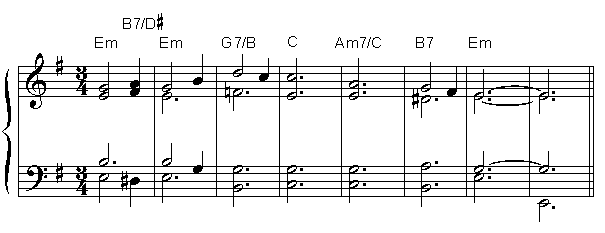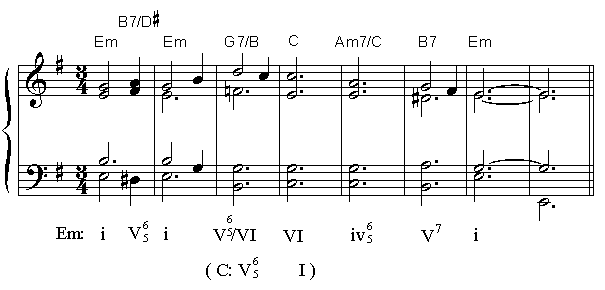
| Listen to the excerpt. | Return to the top. | Check your answers to step 1. |
You know the procedure. Please take out a sheet of scratch paper of any kind.
Step 1. Identify each chord using jazz chord symbols. (C, F#, DMI, B7, Ab/ C )
Step 2. Identify each diatonic chord with a Roman numeral. (Diatonic = In The Key)
Step 3. Identify the non-diatonic chords.
Step 1. Identify each chord using jazz chord symbols. (C, F#, DMI, B7, Ab/ C )
(Write the chords on your sheet of scratch paper.)

| Listen to the excerpt. |
Return to the top. |
Check your answers to step 1. |
Please scroll no further unless you have finished step 1.
.
.
.
.
.
.
.
.
.
.
.
.
.
The answers to step 1. The C in bar 3 is an anticipation. The G in the antepenultimate measure is also a nonharmonic tone. Some identify it as an accented passing tone, others call it an appoggiatura.

Step 2. Identify each diatonic chord with a roman numeral. (Diatonic = In The Key)
(Once again, write on your sheet of scratch paper.)
| Listen to the excerpt. |
Return to the top. |
Check your answers to step 2. |
Please scroll no further unless you have finished step 2.
.
.
.
.
.
.
.
.
.
.
.
.
.
The answers to step 2. Harmonic progressions through the circle of 5ths are also very common in minor, e.g. VI-iio-V-i. Here iv substitutes for iio.

| Listen to the excerpt. |
Return to the top. |
Proceed to step 3. |
Step 3. Identify the non-diatonic chords. Secondary chords function like mini-modulations. They feature what appears to be an authentic cadence in a new key and therefore usually require an accidental or two.

| Listen to the excerpt. | Return to the top. | The answers to step 3. |
Please scroll no further unless you have finished step 3.
.
.
.
.
.
.
.
.
.
.
.
.
.
The answers to step 3. The VI chord is embellished. Note the mini-modulation to C major.

| Listen to the excerpt. | Return to the top. |
If you found this tutorial helpful and want more like it, or if you have any suggestions, please e-mail me at wielandb@northern.edu or tell me in person. Thanks!